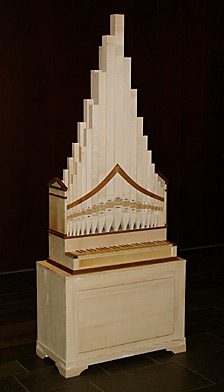WOODEN PIPE ORGAN - ORGANO DI LEGNO

![]()
This small organ with wooden pipes is a reconstruction of part of the instrument made by Lorenzo da Pavia in Venice in 1494 that is now kept in the Museo Correr, Venice, Italy. It reproduces a type of Italian chamber instrument which was well known in the Renaissance, but of which there appear to be no other surviving examples. Such instruments were prized for their sweet sound, described as "soave".
Since the original instrument stands 3.20 m high (too high for many modern rooms) I have produced a smaller version a fifth higher in pitch which just uses Lorenzo's pipes from c upwards. This also has the advantage of bringing the music into a tonal range where the sound of the pipes is clearer and more focussed. Lorenzo's organ was pitched at a' = 455 Hz (± 4 Hz), one of the fairly high Venetian instrumental pitches. The compass is F,G-f³ (i.e. no F#), as in the original, which retains the possibility of using the upper part of the range for repeating melodies at the octave.
The original instrument was made using paper pipes (organo di carta), a technique I have investigated that involves soaking layer after layer of paper in hot hide glue, but owing to the extreme cost of this type of construction I have used the more normal Italian style with square wooden pipes. Tonally there is no difference, since the perceived acoustical timbre of wood or paper pipes depends on the windway and its voicing.
Although only 52 of the original 96 pipes survive, Lorenzo's scaling design can be extracted from the surviving parts. The pipes are scaled like larger Italian organs and are fairly narrow, so that they would be described as a "string" register in modern organ parlance.
These pipes are in effect like Renaissance recorders and with their long windway have a different starting sound to that normally experienced with wooden pipes. The sound is smooth, without a starting "chiff" and sounds almost like a larger Italian, metal-piped organ heard from a distance. The logic of this is understandable for an organ to be played in a smaller room (rather than large hall) where the player sits directly in front of the pipes.
Lorenzo wrote of this 2-register organ (8' and 4') on the 24th of October 1506 to Isabella d'Este who was considering buying it: "...and if it were to be made today I would not make it even if I were given more than 300 ducats." The 8-register church organ Vincenzo Colombo made in 1532-4 for Valvasone cost (without decoration) 300 ducats! Having experienced the difficulty first hand of voicing pipes with this style of windway I can now understand why Lorenzo might have written this!
Lorenzo's instrument was designed using certain proportions for the case work and based on the Venetian inch. There is a relationship between the length of the longest pipe (38 Venetian inches speaking length) and the case, which I have preserved in creating this instrument. The whole instrument stands 2113 mm (83.2" UK/USA inch) high.
The pipes have a mouth which is 1/6 of the circumference of an equivalent round pipe and are thus relatively quiet, as is appropriate for private music making in moderately-sized rooms. I also offer this instrument with pipes designed for a larger volume of sound (mouth = 1/4 pipe circumference), suitable for ensemble playing and at normal 8' pitch.
(The photo shows the instrument at a stage before the cover plates have been added at the mouths. As a result you can see a gap above and below the movable blocks, which appears to be two mouths and has puzzled many. The stand has yet to be painted and not all parts of the maple wood have been oiled, which accounts for the different shades.)